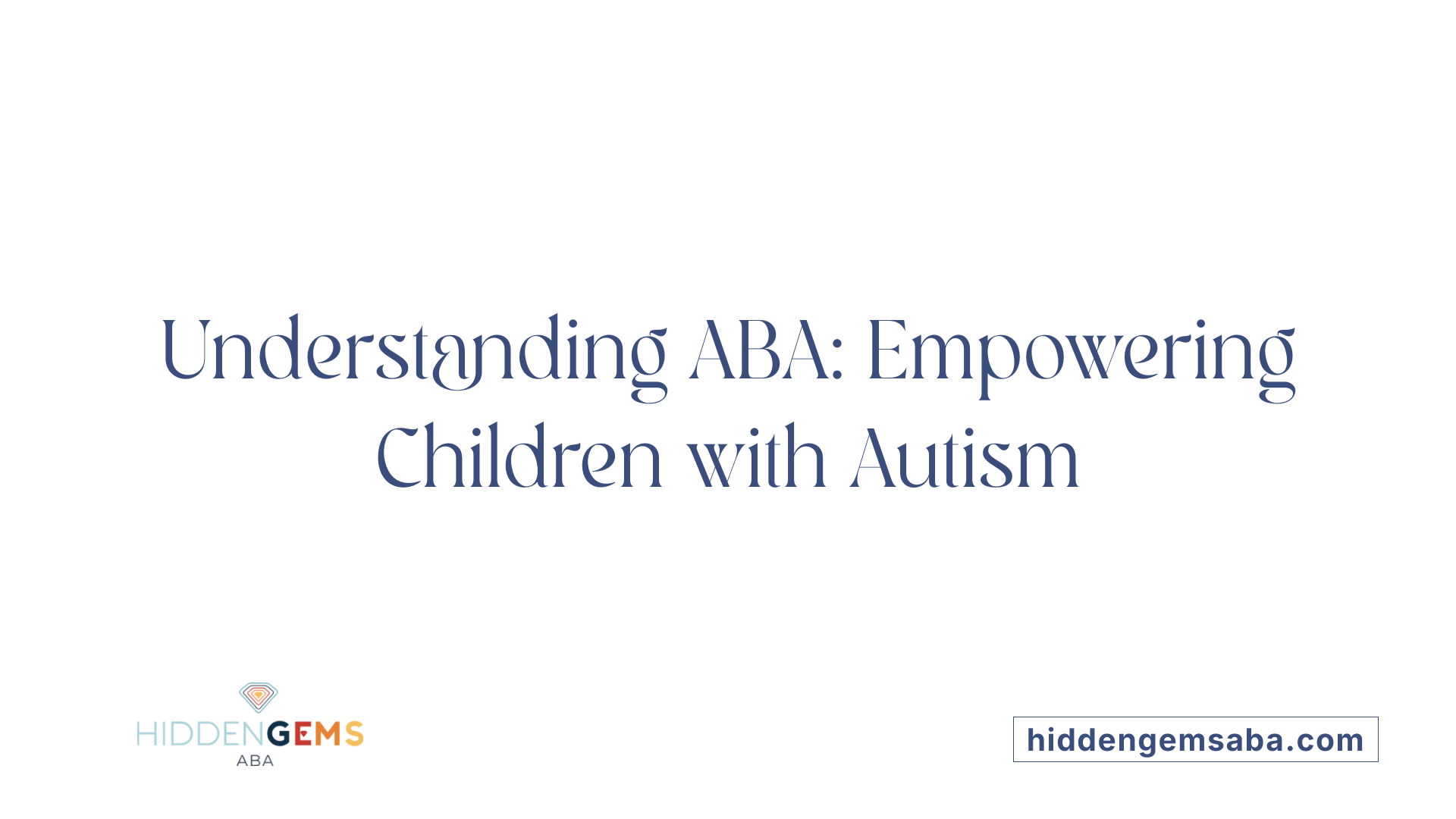Understanding the Role of ABA Therapy in Emotional Regulation
Applied Behavior Analysis (ABA) therapy is widely recognized as a leading evidence-based approach for supporting children with autism, particularly in developing crucial emotional regulation skills. Emotional regulation—the ability to recognize, understand, and manage feelings such as frustration, anger, or anxiety—is a pivotal challenge for many autistic children. Through structured techniques rooted in behavioral science, ABA therapy not only helps reduce disruptive behaviors but also equips children with personalized strategies to cope with emotional challenges, fostering resilience and enhancing quality of life. This article explores how ABA therapy supports emotional regulation alongside broader developmental goals, highlighting therapeutic methods, the importance of family involvement, and ongoing research affirming its effectiveness.
What is ABA Therapy and How Does It Support Children with Autism?

What is Applied Behavior Analysis (ABA) therapy and how does it help individuals with autism?
Applied Behavior Analysis (ABA) therapy is a scientifically grounded approach that uses behavior principles to help children with autism develop important skills and reduce challenging behaviors. Rooted in behaviorist theories, ABA focuses on increasing helpful behaviors—such as communication, social skills, and independence—while carefully reducing disruptive actions through methods like positive reinforcement.
How does ABA therapy improve communication, social skills, independence, and emotional regulation?
ABA therapy supports communication by teaching children to express their needs and understand others, using individualized methods including speech, sign language, or assistive devices. It enhances social skills like sharing, turn-taking, eye contact, and understanding social cues by practicing these in structured activities and real-world settings. Independence is fostered through teaching daily living routines—brushing teeth, toileting, dressing—step by step, encouraging self-sufficiency. Emotional regulation is strengthened by helping children recognize feelings like frustration and anger, and learn calming strategies using visual aids and modeling.
What are the benefits of early, intensive ABA intervention?
Starting ABA early, often between ages 2 and 6, and engaging in intensive programs (25+ hours weekly) leads to significant improvements in language, intellectual functioning, social skills, and daily living abilities. Research supports that higher intensity and early intervention correlate with better long-term outcomes, helping children reach greater independence and social inclusion.
In what settings is ABA therapy delivered, and how?
ABA is versatile and can be provided at home, school, or specialized centers like Lighthouse Autism Center. Center-based therapy offers a controlled, resource-rich environment ideal for focused learning and peer interaction. Treatments are typically individualized and delivered one-on-one by trained professionals, using evidence-based techniques such as Discrete Trial Training and Natural Environment Teaching to ensure skills generalize across settings.
How are ABA therapy plans personalized?
Each ABA therapy program is tailored specifically to the child's unique strengths, challenges, and developmental stage. Board Certified Behavior Analysts (BCBAs) design clinical plans based on thorough assessments of behaviors and skills, setting measurable goals. Family involvement is emphasized throughout treatment to maintain consistency and reinforce learning in everyday life.
ABA therapy remains the gold standard for autism interventions due to its strong scientific foundation, flexibility, and proven success in enhancing communication, social competence, independence, and emotional wellbeing in children with autism.
Core Techniques in ABA Therapy Supporting Emotional Regulation and Behavior

What techniques are commonly used in ABA therapy to support individuals with autism?
ABA therapy incorporates several structured and evidence-based techniques to help children with autism develop skills and manage behaviors effectively.
Positive reinforcement is a cornerstone method that rewards desired behaviors, encouraging their repetition. For example, praising a child for using words to express a need increases the likelihood of that behavior recurring.
Discrete Trial Training (DTT) involves teaching new skills through clear, focused, and repetitive trials. Each trial includes a prompt, a child's response, and a consequence, which helps break down complex behaviors into manageable steps.
Natural Environment Teaching (NET) uses everyday settings and routines to promote learning in real-world contexts. Skills taught in playtime or mealtime become meaningful and easier to generalize.
Prompting and fading are techniques designed to guide children toward independence. Initially, prompts such as verbal hints or physical guidance help the child respond correctly; these prompts are gradually faded to encourage the child to perform the behavior unaided.
Behavior chaining breaks complex tasks into smaller linked steps, teaching each part sequentially until the entire behavior is mastered. This technique is useful for teaching daily living skills like tooth brushing or dressing.
Behavior contracts establish clear agreements between the child and therapist/family, clarifying expected behaviors and rewards, which helps in reinforcing positive actions.
Visual models and tools such as picture schedules, videos, and social stories support understanding and predicting routines, which can soothe anxiety and aid emotional regulation.
Functional Behavior Assessment (FBA) identifies the causes and purposes of challenging behaviors, guiding the development of replacement behaviors that fulfill the same need without being disruptive.
Together, these techniques create a personalized, compassionate, and effective intervention roadmap. They improve communication, promote social skills, support emotional regulation, and reduce problematic behaviors, fostering independence and enhanced quality of life for children with autism.
Supporting Emotional Regulation: Strategies and Tools in ABA Therapy

Teaching recognition of emotions
ABA therapy helps children with autism learn to recognize their emotions, such as frustration and anger, through targeted instruction. This recognition is the foundation for managing feelings effectively and is often personalized to each child’s needs.
Calming strategies and coping skills
Children are taught various calming techniques, including deep breathing, counting, and using calming spaces, to help them regulate emotions when feeling overwhelmed. These coping skills foster self-control and reduce emotional outbursts.
Use of visual supports and modeling
Visual tools like emotion charts, cue cards, and social stories are used to aid understanding and communication of feelings. Therapists and caregivers model appropriate emotional responses, demonstrating healthy ways to express and manage emotions.
Replacement behaviors for tantrums and aggression
ABA therapy identifies triggers for challenging behaviors such as tantrums and aggression. Through functional behavior assessments, children learn replacement behaviors that serve the same purpose but are socially acceptable and less disruptive, improving family life quality.
Generalization of emotional skills across settings
A critical aspect of ABA therapy is helping children apply emotional regulation skills not only in the therapy center but also at home, school, and community settings. This ensures consistent use of strategies and supports long-term emotional well-being.
Measuring the Impact: How ABA Therapy Progress is Assessed

Data Collection and Behavioral Observation
ABA therapy progress is closely monitored through systematic data collection and careful behavioral observation. Therapists record specific behaviors and responses during sessions to quantify improvements in skills and reduction of challenging behaviors. This ongoing documentation provides a detailed picture of a child’s development over time.
Use of Standardized Tools and Assessments
Standardized assessments complement direct observation by providing objective measures of a child’s abilities. Tools like the Patient Outcome Planning Calculator (POP-C) help evaluate symptom severity and guide the intensity of intervention needed. Instruments such as the Vineland Adaptive Behavior Scales and the Verbal Behavior Milestones Assessment and Placement Program (VB-MAPP) measure communication, social, and adaptive skills, allowing for consistent tracking across different domains.
Monitoring Communication, Social, and Emotional Growth
Progress is gauged across multiple facets of development including communication, social interaction, and emotional regulation. Improvements in expressing needs, understanding others, engaging in social exchanges, and managing emotions are specifically tracked to ensure therapy addresses the child’s comprehensive needs.
Goal Tracking and Individualized Treatment Adjustments
Each child’s ABA program is built around individualized goals. Regular progress reviews allow therapists to adjust treatment plans dynamically, introducing new objectives or modifying strategies to optimize learning and skill acquisition. This flexible approach ensures therapy remains effective and responsive to the child's evolving abilities.
Role of Licensed Behavior Analysts (BCBAs)
Licensed professionals, especially Board Certified Behavior Analysts (BCBAs), oversee the assessment and treatment process. They analyze collected data, interpret assessment outcomes, and make informed decisions about program modifications. Their expertise ensures that progress measurement is accurate and that interventions are evidence-based and tailored to the child’s specific profile.
Who Provides ABA Therapy? Credentials and Professional Roles

Qualifications of Board Certified Behavior Analysts (BCBAs)
ABA therapy is primarily provided by Board Certified Behavior Analysts (BCBAs), professionals who have completed advanced education and training in behavioral analysis. Typically, BCBAs hold a master’s degree in fields such as applied behavior analysis, psychology, or education. They must accumulate between 1,500 and 2,000 hours of supervised fieldwork and pass a rigorous certification exam administered by the Behavior Analyst Certification Board (BACB).
Role of Registered Behavior Technicians and Licensed Therapists
Registered Behavior Technicians (RBTs) and licensed therapists also play important roles in delivering ABA therapy. RBTs work under the direct supervision of BCBAs, implementing therapy sessions and data collection. Licensed therapists with specialized training in behavioral analysis often contribute to treatment, particularly in multidisciplinary teams. These professionals ensure that the intervention plans are followed correctly and adapt strategies as needed.
Education Requirements and Certifications
To practice ABA therapy, providers must meet specific education and certification standards. The BACB certification ensures that practitioners understand behavior principles, ethical considerations, and best clinical practices. Besides the BCBA, other certification levels include Board Certified Assistant Behavior Analyst (BCaBA) and RBT, each requiring different education and supervised experience hours.
Settings Where ABA Is Delivered
ABA therapy is delivered in a variety of settings to best meet individual needs. This includes center-based environments like those at the Lighthouse Autism Center, as well as homes, schools, and community clinics. Each setting offers unique benefits—for example, center-based therapy provides a controlled, resource-rich environment, while home and school delivery promotes generalization of skills.
Collaboration with Families and Other Professionals
Successful ABA therapy involves active collaboration with families, educators, and other professionals. BCBAs and therapists regularly train parents and caregivers, providing guidance to sustain therapy gains across different environments. They also coordinate with teachers, speech therapists, and medical providers to ensure integrated and consistent care that supports the child’s overall development.
| Role | Qualification Requirements | Typical Responsibilities |
|---|---|---|
| Board Certified Behavior Analyst (BCBA) | Master’s degree, supervised experience (1500-2000 hours), BACB certification | Develops and oversees treatment plans, supervises therapy sessions, trains other staff |
| Registered Behavior Technician (RBT) | Certification through BACB, supervised by BCBA | Implements therapy protocols, collects data, assists in daily ABA activities |
| Licensed Therapist | Relevant state license and behavioral analysis training | Delivers therapy, coordinates with multidisciplinary teams, provides clinical support |
ABA therapy providers combine specialized education, certification, and hands-on experience to help children with autism thrive in diverse settings while fostering family and professional partnerships.
Addressing Emotional Regulation Challenges Through Family Involvement and Support

Importance of Caregiver Training and Involvement
Families play a vital role in supporting children with autism undergoing ABA therapy, especially in managing emotional regulation challenges. Caregiver training equips family members with the tools and strategies needed to reinforce calming techniques and emotional coping skills consistently outside therapy sessions. This involvement ensures children receive a unified approach to managing emotions like frustration and anger.
Enhancing Consistency Across Environments
Consistency across home, school, and community settings is critical for the success of ABA therapy. When families are actively involved and trained, they help create an environment where therapeutic goals are supported throughout daily routines. This uniformity fosters generalization of emotional regulation skills and reduces confusion that could arise from mixed messages.
Family Role in Reinforcing Coping Strategies
Caregivers reinforce coping mechanisms taught during therapy, such as the use of visual aids or modeled calming strategies. By practicing these methods regularly, families enable children to internalize emotional regulation techniques, improving their ability to self-soothe and respond appropriately to stressors.
Navigating Access to ABA Therapy Services
Families can access ABA therapy through providers such as Board Certified Behavior Analysts and registered behavior technicians after securing an autism diagnosis and behavioral assessment. Insurance, including Medicaid programs like Arizona Medicaid, often covers services but requires prior authorization. Researching local resources and securing funding is essential. Training and support empower families to overcome barriers related to cost, location, and information.
Strategies to Empower Families
To empower families, ABA programs often provide ongoing education, clear communication, and collaborative goal-setting. Engaging caregivers in progress monitoring and decision-making creates a partnership that enhances therapy effectiveness and emotional outcomes for the child. Support groups and resource networks also help families share experiences and maintain motivation.
Ethical Considerations and Controversies in ABA Therapy

What are some controversies or criticisms associated with ABA therapy?
ABA therapy, while recognized as an effective treatment for autism, has faced controversies around its ethical implications. Historically, ABA programs sometimes used intense and rigid methods, including aversive techniques, which some individuals and families report as emotionally distressing. Critics argue that this past focus on compliance and behavior suppression could overlook the individual's autonomy and natural behaviors.
Another major concern involves the therapy's impact on autistic identity. Some autistic self-advocates highlight that ABA has at times encouraged masking or suppressing natural autistic traits like stimming, which are vital aspects of self-regulation and identity. They caution that pushing children to conform to neurotypical social norms may cause emotional harm and reduce authenticity.
How has ABA therapy addressed these ethical concerns?
Modern ABA practices have increasingly embraced person-centered and respectful approaches. This shift includes an emphasis on positive reinforcement, naturalistic teaching settings, and individualized treatment plans that prioritize improving the child's quality of life rather than mere behavior compliance.
What is the current state of the debate on ABA therapy's ethics?
Despite improvements, ongoing debates persist about ABA's emotional effects and appropriateness for every autistic individual. Advocacy groups call for continued refinement of therapy to ensure dignity, respect, and involvement of autistic voices and families in treatment planning. There is a growing consensus on the necessity of ethical frameworks that protect autonomy, avoid harm, and focus on meaningful life skills.
Why is family collaboration important in ethical ABA practice?
Families play a crucial role in ensuring that ABA therapy is aligned with the child's needs and values. Their involvement helps maintain consistent, supportive environments and enables therapists to tailor interventions sensitively. Open communication and training empower families to contribute actively to ethical and effective therapy.
In summary, while ABA therapy faces valid ethical criticisms rooted in its history, ongoing advances and growing awareness are shaping a more respectful, individualized, and ethical practice that centers on the well-being and authentic development of autistic children.
The Future of ABA Therapy in Supporting Emotional and Social Development

Advancements in Technology Integration
The future of ABA therapy is increasingly intertwined with technological innovation. Tools such as wearable devices, mobile apps, and data tracking software are being integrated into therapy sessions to provide precise, real-time feedback. These technologies allow therapists to monitor progress more effectively and adapt strategies promptly, supporting personalized learning and emotional regulation.
Personalized Data-Driven Treatment Plans
Treatment plans are becoming ever more individualized through sophisticated data analysis. By collecting continuous data on a child's responses and behaviors, therapists can craft plans tailored to unique needs and preferences. This approach enhances the effectiveness of interventions targeting social skills, emotional understanding, and communication.
Focus on Ethical, Respectful Interventions
Modern ABA therapies emphasize respect for children's autonomy and dignity. Ethical considerations now play a significant role, with therapy approaches designed to be person-centered and culturally sensitive. Families are actively involved in decision-making processes to ensure interventions align with their values and to promote trust and collaboration.
Expanding Roles of Family and Community
The role of families and broader communities is recognized as vital for long-term success. Future practices will continue to strengthen parent and caregiver training, empowering them to reinforce skills consistently across settings. Community involvement also supports generalization of social and emotional skills, fostering inclusive environments that encourage social participation.
Ongoing Research Validating Efficacy
Continued research reaffirms ABA’s effectiveness while exploring refinements to maximize benefits. Studies focus on advancing techniques for emotional regulation and social development, ensuring strategies remain evidence-based. Investigations into personalized and ethical methodologies further support ABA's role as a leading therapy for children with autism.
Advancing Emotional Well-Being Through ABA: A Collaborative Path Forward
ABA therapy stands as a scientifically validated and dynamically evolving approach that plays a crucial role in supporting emotional regulation for children with autism. By combining structured, evidence-based interventions with a compassionate focus on individual needs and family involvement, ABA fosters skills that empower children to better understand and manage their emotions, improve social interactions, and gain independence. While rooted in behaviorist principles, the field continues to refine its methods to emphasize ethical practices, respect for neurodiversity, and long-term quality of life. Families, therapists, and communities working collaboratively can unlock ABA’s full potential, helping children with autism navigate emotional challenges and thrive across life’s varied settings.
References
- Benefits of ABA Therapy for Children with Autism
- What is ABA Therapy For Autism?
- Applied Behavioral Analysis | Research Starters
- Exploring the Importance of ABA Therapy for Autism
- The Benefits of ABA Therapy for Autism
- 5 Evidence-Based Benefits Of ABA Therapy For Children ...
- A Tool for Determining Treatment Dosage in Applied ...


.avif)


